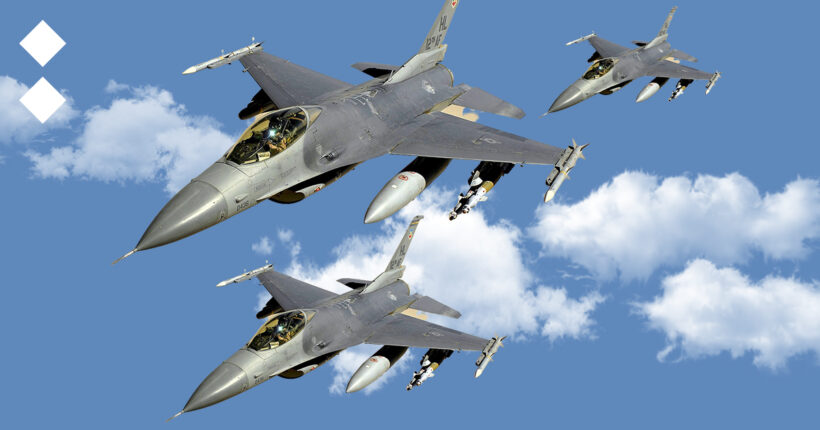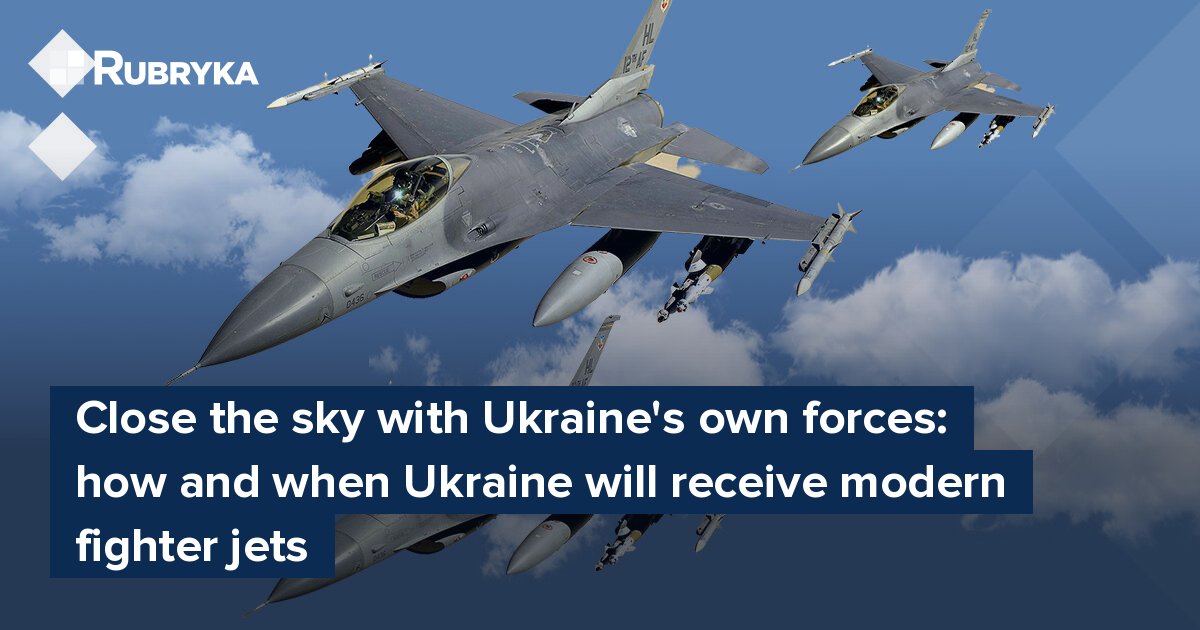
When will Ukraine receive the F-16?
"Today, 11 partner countries and Ukraine signed a memorandum that defines the conditions. I am especially grateful to Denmark and the Netherlands for their exceptional leadership in this process," Oleksii Reznikov, Ukraine's Defense Minister, wrote from Vilnius on July 11.
Indeed, at the summit, Ukraine did not receive such a desired invitation to NATO, but a block of countries that will help Ukraine get F-16 fighters and everything necessary for them was finally formed. Meet Denmark, Netherlands, Belgium, Canada, Luxembourg, Norway, Poland, Portugal, Romania, Great Britain, and Sweden will be the ones to help Ukraine regain its independence.
You can even roughly calculate how many planes there will be. The principle of the more, the better, applies here, but for now, Ukraine is counting on 40 to 50 F-16 fighters. However, according to Defense Express, Ukraine's Air Force may receive 24-36 aircraft in the first batch.
Anonymous Western officials told Politico that this would happen in early 2024. At the NATO summit in Vilnius, the head of the Ukrainian Foreign Ministry, Dmytro Kuleba, named a similar timing: January-March 2024.
However, he clarified that the terms may change. The transfer of F-16 fighters is a complex operation because it is necessary not only to bring the planes but also to train pilots, ground technicians and prepare the infrastructure in Ukraine.
The Americans, meanwhile, are optimistic, with John Kirby, the US National Security Council's strategic communications coordinator, saying the F-16s could arrive in Ukraine even before the end of 2023. Nevertheless, this is still later than necessary. According to Commander-in-Chief Valerii Zaluzhnyi, fighter jets would be an important weapon for Ukraine's counteroffensive.
The main hopes, for now, are the Netherlands and Denmark, but let's not forget about the US
That's right, the main aircraft donors are the Netherlands. According to Bloomberg, Amsterdam agreed to this back in May.
The Netherlands has 42 F-16 fighter jets: 24 aircraft in the country's air force, and the rest have already been decommissioned and ready to be sold to the private company Draken International. However, in May, the Netherlands abruptly changed its mind and canceled the agreement on 18 planes — most likely, they will go to Ukraine.
Perhaps later, Ukrainian Air Force will receive another 24 fighters. After all, by the middle of 2024, the Netherlands wants to completely remove F-16s from its army because state-of-the-art F-35s will replace them.
The Danes have a similar situation. They also have 30 F-16 aircraft and plan to abandon them in favor of the F-35. True, this was supposed to happen as early as 2025, but the first F-35s will appear already this year, so the Scandinavians can speed the process up.
Previously, Copenhagen agreed to transfer fighter jets to Ukraine, and in general, the Scandinavian country is one of the leaders of the fighter coalition.
Other allies are not so decisive yet. For example, the Poles will not share any of their 48 F-16 fighters. They have Belarus and the Krolevets region of the Russian Federation next to them, and in December, a Russian X-55 missile flew unnoticed to central Poland. Unsurprisingly, Warsaw wants to be armed as much as possible, so it is buying additional combat aircraft from South Korea. However, they could send modernized MiG-29s to Ukraine.
Belgium has much better neighbors, but the country will not provide fighter jets nonetheless — they say they are needed to protect the airspace of Benelux(!) and the Baltic countries. The Portuguese also talk about defense capability — however, they are ready to share spare parts.
Romania and Turkey themselves buy combat aircraft, and Greece, although it has more than 150 fighters, does not transfer modern weapons to Ukraine. There is even less chance of getting F-16 from non-European countries like Israel, Egypt, South Korea, or Chile, which for various reasons, remain neutral in this war.
The United States of America stands apart, which does not officially participate in the coalition, but has as many as 936 F-16 fighters. Of course, the USA does not plan to disarm, but it could transfer 30-40 aircraft to Ukraine without significantly damaging its Air Force.
However, this is a sensitive topic for America because Washington is constantly wary of provoking Russia, and critics of President Joe Biden like to say that he spends too much money on Ukraine.
However, there is reason to hope that the United States will provide our F-16 with fuel, missiles, bombs, and spare parts from its own reserves because it is unlikely that Denmark or Poland will be able to cover all the needs on their own.
The main problem which is already being solved is not the planes, but the pilots
The difference from the situation with the Leopards-2, for example, is that the armies train their tank crews on their own training grounds. Future pilots must be taught by certified instructors, which are not available in every country. Plus, training aircraft are needed, like the two-seat version of the F-16, where the pilot flies with an instructor.
As a result, the problem that there are planes but nowhere to train pilots arose even in Romania, a full NATO member. The allies eventually found places for Ukrainian pilots, but there was a delay, and instead of June, the training will start in August.
A group of Ukrainian pilots will go to the already mentioned Romania and start training there. The southern neighbors have F-16 planes and instructors, and the company Lockheed Martin, the manufacturer of fighter jets, promises to help. The Romanians will even hire a private company, Draken International, which also trains combat pilots.
The Danes are taking 10 to 12 Ukrainian pilots for training, and the place has already been determined: Skrudstrup Air Base. Poles are also ready to help but do not share details. Previously, the Portuguese and Norwegians also volunteered to train our pilots.
Moreover, 20 pilots of the Ukrainian Air Force, according to the ex-ambassador of Ukraine to Great Britain, Vadym Prystaiko, will undergo training in the United Kingdom. Interestingly, the British do not have any F-16, so it will most likely be theoretical training like the one that drivers go through in driving schools before getting behind the wheel.
In short, the first group of Ukrainian pilots has already done their homework (i.e., studied the aviation terminology in the native English language for the F-16) — they just have to wait for the trip abroad.
Another problem was solved when, on July 16, the US President's national security adviser, Jake Sullivan, confirmed that America allows Europeans to train Ukrainian pilots. Without this, Denmark and other countries had no right to act. If it passes without emergencies, there is a good chance to start in August and finish in January. After all, according to the chief of aviation of the Air Force Command of the Armed Forces of Ukraine, General Serhiy Holubtsov, the Americans were ready to train Ukrainian pilots in less than six months. The Minister of Defense of the Netherlands, Kajsa Ollongren, predicted a slightly longer process of six to eight months, but the numbers are generally similar.
At the same time, the allies will train the ground personnel because the F-16 needs to be serviced, refueled, equipped with missiles and bombs, and sometimes repaired. Poland, Portugal, and Norway previously agreed to train aviation technicians — the Scandinavians have already written off these planes, but the experience remains. Canada will help prepare Ukrainian airports to receive the F-16. Luxembourg will likely help other countries, as its air force only has one transport aircraft.
So the only mystery remained: Sweden's role. The Scandinavians are also ready to train Ukrainian pilots but on their JAS-39 Gripen fighters. This is a victory, but Stockholm does not plan to provide the planes themselves.
Alternatively, Sweden can wait until it is accepted into NATO, and only then will it announce fighter jet assistance. Neighboring Finland set such a condition when Ukraine asked for Leopards-2. The Swedes have 96 fighters; theoretically, they can transfer 16 JAS-39 by ordering new ones from the manufacturer.
How the F-16 will help on the battlefield: drive away Russian planes and hit missiles from afar
Let's warn you immediately: F-16s will not become a superweapon with which the Ukrainian army will reach Crimea in a flash. Western aircraft brought the US and its allies an easy victory during Desert Storm. Still, the coalition used hundreds of combat vehicles there, and the Iraqis had weak aviation and air defense.
However, this will not make the F-16s any less important: they are critically needed to close the sky over the front line and the border. Yes, Ukraine's air defense protects the rear and prevents the Russians from flying into the country. Still, near the front line, the Russian Federation takes full advantage of its aviation advantage to launch missiles and drop glider bombs on Ukrainian troops. This has already become a problem during a counteroffensive.
The Ukrainian Air Force cannot repulse the enemy because Russian fighters have more powerful radars and longer-range missiles. The aggressors will be the first to detect Ukrainian planes and shoot at them from afar with impunity.
With the F-16, however, the balance will swing in Ukraine's direction. More modern radars will allow Ukrainian pilots to spot the Russians in time. For the attack, Ukraine's aviators will have AIM-120 AMRAAM missiles — they can fly up to 160 kilometers and operate according to the shoot-and-forget principle — simply put, they pursue the target themselves.
By the way, the AIM-120 also works against helicopters, and this is good news for the Armed Forces because the Russian Federation is increasingly using its Ka-52 against Ukrainian armored vehicles. The F-16 can shoot down Russian cruise missiles and drones off the battlefield.
"The integration of avionics, weapon systems, and weapons is decades ahead of what they're flying now. There will be greater capability, radar range, and weapon range," explained General Philip Breedlove, the former Supreme Commander of NATO forces in Europe. However, he added that the F-16 is not a panacea.
In addition to purely fighter sorties, the F-16 can act as an attack aircraft: Maverick missiles can target ground targets more than 22 kilometers away, and HARM-88 and guided air bombs are also more effective if launched from a native aircraft. In total, the fighter has nine hangers for missiles or bombs.
In the future, the F-16 may become the main carrier of long-range weapons for the Ukrainian Armed Forces. The US and its allies have analogs of the British Storm Shadow, SLAM-ER, and JASSM cruise missiles for such a case. The first of them reaches 280 kilometers; the second can fly already 370, and its improved version JASSM-ER — more than 900. The missile launched over Kyiv will reach the target in Sevastopol in Crimea. With them, the Ukrainian Air Force will be able to hit the Russian headquarters, warehouse, or base in any part of Ukraine.
Of course, Ukraine will still have to convince its allies to provide these weapons, but the US purchased about two thousand of JASSMs and had plans for another 10 thousand, so this is definitely not such a shortage as the famous ATACMS. It is also possible to hang the Harpoon anti-ship missile on the F-16 and get the Russian ships that are shelling Ukraine.
There is a chance to get additional planes in the future
Ukraine needs even more fighters because although F-16s are cool, Russia only has about three hundred Su-34 and Su-35. Ukraine can hope that everything will not be limited to 40 to 50 planes.
After all, F-16 operator countries such as Poland, Belgium, and Portugal are gradually decommissioning them and switching to the F-35. Ukraine will have a chance to convince its allies and take the planes for itself. This will be a repetition of the tank coalition when each state shared a small batch of vehicles, resulting in dozens of Leopards.
Here, Ukraine will be greatly helped by Lockheed Martin, which is ready to build new aircraft for countries that will hand over their F-16s to Ukraine.
Another option is to negotiate with the US. Moreover, there is a successful example with armored vehicles: at first, Ukraine was not given anything, but now Bradley and Strykers are coming in dozens in new aid packages.
What if we look for more than just the F-16? Well, so far, the allies have offered Ukraine no other type of aircraft. Ukraine supposedly started negotiations with Australia, which wrote off 41 F-18 fighters, but there was a problem with the technical condition of the machines. Only 14 of them can be restored to working condition, so it is worth waiting for new details.
However, the conversation about Western planes finally moved from discussions about whether to provide them to Ukraine to "how much?" and "when?" which is a huge step forward. It is important not to stop because the lives of Ukrainian soldiers depend on it.







